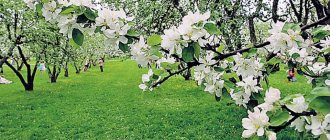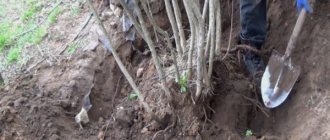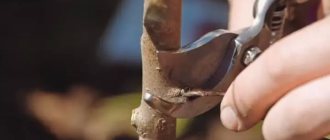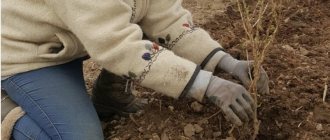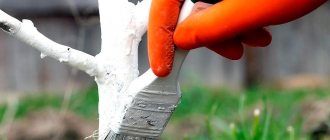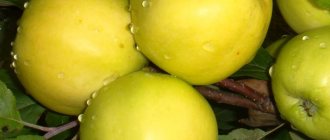Suitable varieties for the Moscow region
The regionalization of a variety is a mandatory condition when purchasing an apple tree for a garden plot.
The climate of the Moscow region is characterized by cold winters, long autumns, and spring reverse frosts. These features cannot be ignored, as they directly affect the survival rate, development and productivity of the crop. Most gardeners choose winter-hardy varieties that can withstand frost and light snow cover. According to the ripening period, apple trees are divided into summer, autumn and winter.
Summer varieties
Summer apples ripen in July–August, they are juicy and sweet, but they are hardly stored:
- “Melba” has a caramel, sweet and sour taste. Fruit weight 140–300 g, round, slightly flattened, red-yellow with a greenish side. The tree reaches up to 5 m in height and bears fruit in the 5th year.
- “Grushovka Moskovskaya” are aromatic red-pink sweetish apples, weighing 100 g. They ripen gradually and last in the cellar for 2–3 weeks. In a good year, a mature tree produces 80–170 kg of harvest. Withstands frosts down to -45 °C, but drops fruits during drought.
- "Arkadik" is a modern hybrid, cold-resistant, productive, and scab-resistant. The average height is 4–5 m; in the 3rd year it will produce the first harvest in early August. Apples 120–340 g, with a slight sourness and bright aroma, can be stored for up to 30 days.
Autumn varieties
Autumn varieties ripen 2–3 weeks after harvest and are stored for 2–4 months:
- “Striped anise” is popular due to its resistance to drought and frost; it bears fruit for 70–100 years, starting from the 6th year. Productivity increases as it grows older and reaches 320 kg. Apples 70–90 g with anise flavor, pink with white stripes and specks.
- "Antonovka" is a long-term leader in apple crops. Valued for record yields of 500–1000 kg per tree, resistance to cold and most diseases. The fruits are 150–170 g, very aromatic green, and can be stored for 3–4 months. The pulp is white, sweet and sour, juicy.
- “Autumn Striped” is a tall variety that, depending on age, produces stable yields from 20 to 300 kg. Apples weigh 100–140 g, bright yellow-red color. The pulp is juicy, pink under the skin, with a wine flavor.
Winter varieties
At the end of September – beginning of October, winter varieties ripen and are stored for up to 4–8 months. The dense structure ensures the preservation of presentation during transportation:
- “Moscow winter” - tolerates extreme frosts and is almost not susceptible to pests. Ruddy green-yellow fruits, 200–280 g each, sweet and spicy in taste.
- “Orlovskaya Zarya” - has high taste, raspberry-red apples 100–150 g each. Starting from the 4th year, the yield increases to 170–180 kg per tree.
- “Bogatyr” is a hybrid of “Antonovka” and “Renet of Landsberg”. It bears fruit in the 7th year with large light yellow apples weighing 120–200 g. They ripen in September, but are harvested in October to preserve taste and shelf life.
If there is no possibility or desire to store the harvest, then it is enough to have two trees of the autumn variety and one of each summer and winter in the garden.
Video
WHEN TO PLANT apple and pear trees IN AUTUMN. We determine the readiness of seedlings for sale.
How to plant an apple tree / Proper planting of a seedling in spring
Choosing the BEST TIME to plant seedlings
When is it better to plant trees in the garden: autumn or spring?
Rules for planting apple, pear, cherry and plum seedlings.
You need to know before planting apple, pear, cherry, and plum trees. Where to plant fruit trees.
WHY IS IT BETTER TO PLANT TREES IN AUTUMN. In addition to apricot and peach
Never buy such seedlings. How to choose fruit tree seedlings.
PLANT AN APPLE TREE ONLY THIS WAY! How to plant an apple tree correctly?
Planting an apple tree: revealing secrets. How to plant an apple tree with high groundwater
22. Planting an apple tree. How to plant an apple tree.
When to plant seedlings in the fall / Timing of autumn planting / Igor Bilevich
How to plant APPLE TREE seedlings in autumn – Nursery Gardens of the Urals
About landing dates. When is the best time to purchase and plant fruit crops in the fall? Professional opinion
How to plant a pear in the fall / a method proven over the years
Seedlings in autumn. How to plant seedlings in late autumn. 100{9affb1c4ee7d9664357320fc7298f33061302d048359754d18fbb6550c8d5f3e} seedling survival rate.
How do you like the article?
Ivanova Tatyana
Ask a Question
Selecting a site for planting
The place for planting an apple tree requires preparation. Primary requirements:
- An open, sunny area on the leeward side without tall trees growing nearby. Maintain a distance of 3–4 meters from the fence.
- If there are several seedlings, they are planted in a separate group and not mixed with other fruit crops.
- For better pollination, apple trees with different fruiting periods are planted nearby.
- The thin fertile layer of the site is brought to a thickness of 60 cm with freshly imported soil.
- Add sand and compost to clay soil, and humus and peat to sandy soil.
Dry rocky and marshy areas are absolutely not suitable. Be sure to take into account the groundwater level, where 2 meters is the minimum permissible threshold for the safe growth of garden trees.
Tall varieties require 5–6 m of free space, while low-growing varieties require 3 m.
Common gardening mistakes
Planting and caring for apple trees in the Moscow region is similar to other regions of Central Russia. Poor fruiting is often explained by errors during planting:
- The root collar is buried - the plant will take longer to take root.
- Pegs are not installed - the seedling may break in a strong wind.
- If fertilizers are not applied, the plant’s immunity will suffer.
- Thickened plantings - the plant will receive little light.
- Growing in places with close groundwater - the roots may rot.
Preparation for transplanting seedlings
The right time to plant an apple tree in the spring is after the end of night frosts and the moment the buds open. Typically this period in the Moscow region occurs at the end of April - beginning of May. If the bayonet of the shovel easily enters the ground, then it is sufficiently warmed up.
Proper selection of planting material is the key to tree survival and productivity. It is recommended to purchase apple trees from reputable local nurseries. Presented standards:
- age 2–3 years;
- open root system 35–40 cm long without growths, the cut is moist and light inside;
- there are no influxes of formations in place of the scion and rootstock;
- the trunk is smooth, without wounds or cracks;
- the buds are not open.
You should not take thin or thick trees.
Before planting, the seedling is prepared:
- remove root shoots, broken and dead parts of roots and bark;
- damage and cut areas are cleaned and treated with garden varnish;
- placed in water for 12 hours.
If planting is delayed, the roots will not cope with adaptation, the apple tree will dry out or will lag in growth.
When is it better to plant apple trees in the Moscow region: in spring or autumn?
In the Central region of Russia, which includes the Moscow region, apple trees are planted both in spring and autumn. If you purchased a strong seedling with a well-developed root system, then it will take root well in any season.
Planting an apple tree in autumn in the Moscow region
Recommended for 3-4 year old seedlings , because the older the tree, the more time it needs to get used to new living conditions.
When planted in autumn, the apple tree will have time to get used to its new soil and quickly begin to grow in the spring.
When to plant apple trees in the Moscow region in the fall is determined by leaf fall ; work begins after it begins.
At this time, the trees no longer devote their energy to the growth of shoots, but they also have not had time to fall into a state of winter dormancy.
The end of planting work is 15-25 days before the onset of persistent frosts. This time is enough for the tree to take root.
The optimal time for planting is from mid-September to early October.
How to properly plant an apple tree in the fall in the Moscow region depends on the variety and soil.
Spring planting of apple trees
Allows them to get stronger for the next winter and not freeze out during it. It is preferable for seedlings 1-2 years old . Young plants quickly adapt to new living conditions, but are also more susceptible to winter freezing when planted in autumn.
Spring planting is carried out starting from the end of April until mid-May .
TIP : It happens that spring came too early or, on the contrary, it turned out to be late. How to navigate in this case? A simple rule will help: the earth should warm up (thaw) to the point of a shovel.
Landing
Algorithm for planting a seedling:
- A stake 1–1.5 meters high is stuck into the hole.
- Plant a seedling. Maintain a level such that the root collar is 4–5 cm above the ground surface.
- Straighten the roots and cover with the remaining fertilized soil. They compact well so that there are no voids.
- Pour in 4-5 buckets of water.
- The apple tree is loosely tied to the stake with soft twine at the top and bottom using a figure eight knot.
- To stimulate the growth of lateral branches, the central conductor is shortened by 2–3 buds.
Useful tips from experienced gardeners if you have an apple tree in the Moscow region
- Never buy seedlings grown in the southern regions ! In the conditions of the Moscow region, they will freeze out in the first cold winter. The best choice is zoned planting material from the nursery.
- Do not buy tall, 4-5 year old trees , although the temptation is great. They take root poorly and take longer to adapt.
- Wrap the trunks of young seedlings for the winter! This will protect them from hares peeling off the young bark of the plant. It is enough to tie one meter of trunk, starting from the edge of the ground; the hares will not reach higher.
Care
After planting in the Moscow region, the apple tree is mulched with a thick layer of humus, sawdust, rotted manure, and hay.
The shelter will attract earthworms, which will loosen the soil and promote gas exchange. Additional sprinkling with crushed stone or decorative gravel will protect against heat and reduce moisture evaporation.
Watering
The first month after planting, pour a bucket of water under the seedling once a week. In the future, 4-5 buckets are enough for 2-3 weeks.
Water is used from the tank, recommended temperature is +15–18 °C. In rainy spring, watering is stopped. Excessive moisture causes root rot.
If the seedling settles, it is carefully pulled up so that the root collar is above ground level.
Fertilizers
1. When the first blossoming leaves appear on sandy and poor soils, apply 300 g of dry saltpeter once. On chernozems, the fertilizer rate is reduced to 100 g.
2. In the budding and flowering phase, make a solution in 10 liters of water from 50 g of superphosphate, 40 g of potassium sulfate and 500 g of mullein or bird droppings.
3. After flowering, feed with “Nitrophoska” and “Sodium Humate” in accordance with the instructions. Subsequently, dry fertilizers are applied to tree trunk circles and embedded in the soil.
In the first year, it is recommended to pick off the flowers on the apple tree, since flowering contributes to the depletion of the strength of the young plant.
Trimming
Benefits of pruning a young apple tree:
- formation of a beautiful and convenient crown for harvesting;
- removal of unnecessary shoots for better development of branches;
- restoring balance between the reduced root system and the above-ground part;
- sanitary and preventive measure against the development of diseases.
Pruning an annual seedling makes it possible, already in the first year of life, to form lateral shoots that will form the basis of the crown. The upper part of the tree undergoes more shaping to provide the entire crown with sunlight.
Shoots growing at an acute angle to the trunk are removed completely. If the branch forms a right angle, then it is pruned to 3–5 buds. The sections are treated with garden varnish.
In the summer in the Moscow region, it is enough to pinch off excess young shoots to prevent them from growing.
Improper pruning will weaken the tree and reduce yield.
Graft
Grafting is the grafting of a cutting or scion bud onto a rootstock plant where a new branch will grow. The procedure is optional, but it has a positive effect on fruiting and development of the apple tree and saves space in the garden. Advantages:
- varietal diversity is expanding;
- the adult tree is renewed;
- fruits with a new taste and shelf life.
Spring is the most preferred season for grafting in the Moscow region, when the temperature is low, the buds are just swollen and there is no active sap flow.
To work, you will need a fixing tape, a hacksaw, pruning shears, a garden knife or a single-sided blade. Instruments are pre-disinfected with alcohol.
There are different methods of vaccination with their own nuances.
Budding
One of the most gentle techniques is used to add a new variety or form a crown. Procedure:
- Horizontal cuts are made on top and bottom of the kidney;
- use a blade to cut it off along with the bark and tissue underneath;
- a T-shaped cut is made on the apple tree;
- bend the edges of the bark, insert a peephole and secure with tape.
Into the cleft
The method is used when the rootstock is thicker than the scion. It ensures survival and a tight fit, but the downside is that there is a high risk of wood rotting. Stages:
- cut down the branch, leaving 10–30 cm from the trunk;
- a longitudinal split of 4–5 cm is made in the hemp; oblique cuts of 2 cm on each side are made on the cuttings;
- insert cuttings into the split and carefully cover with garden varnish.
Copulation
The method is suitable if the thickness of the shoots is the same. Wherein:
- the edge of the scion is cut off so that there is an oblique cut 2–3 cm long;
- the same cut is made on the rootstock, with a bud on the reverse side;
- connected, wrapped and coated with varnish.
Filling the hole
Next, the prepared planting hole must be properly filled with nutritious soil. If you use fertile fertilizer, the young tree will take root and enjoy good growth.
Ideal mixture for planting hole:
- Top fertile layer of soil. At the same time, it must be laid with grass. As a result of decomposition, humus is formed.
- Compost or humus - a bucket.
- Superphosphate – 100 g;
- Potassium sulfate – 70 g.
If the site has highly acidic soil, then you need to add dolomite flour to deoxidize it. At a strong pH level, 600 g of the substance will be needed, and at an average or weak level - 350-450 g. Heavy and clay soil should be diluted with a bucket of sand, and sandy soil with the same amount of peat.
Then fill the hole so that a depression is formed in it, the size of which is comparable to the root system of the seedling or container, if the root system is closed. Mix this mixture well in the pit, then water a little.

